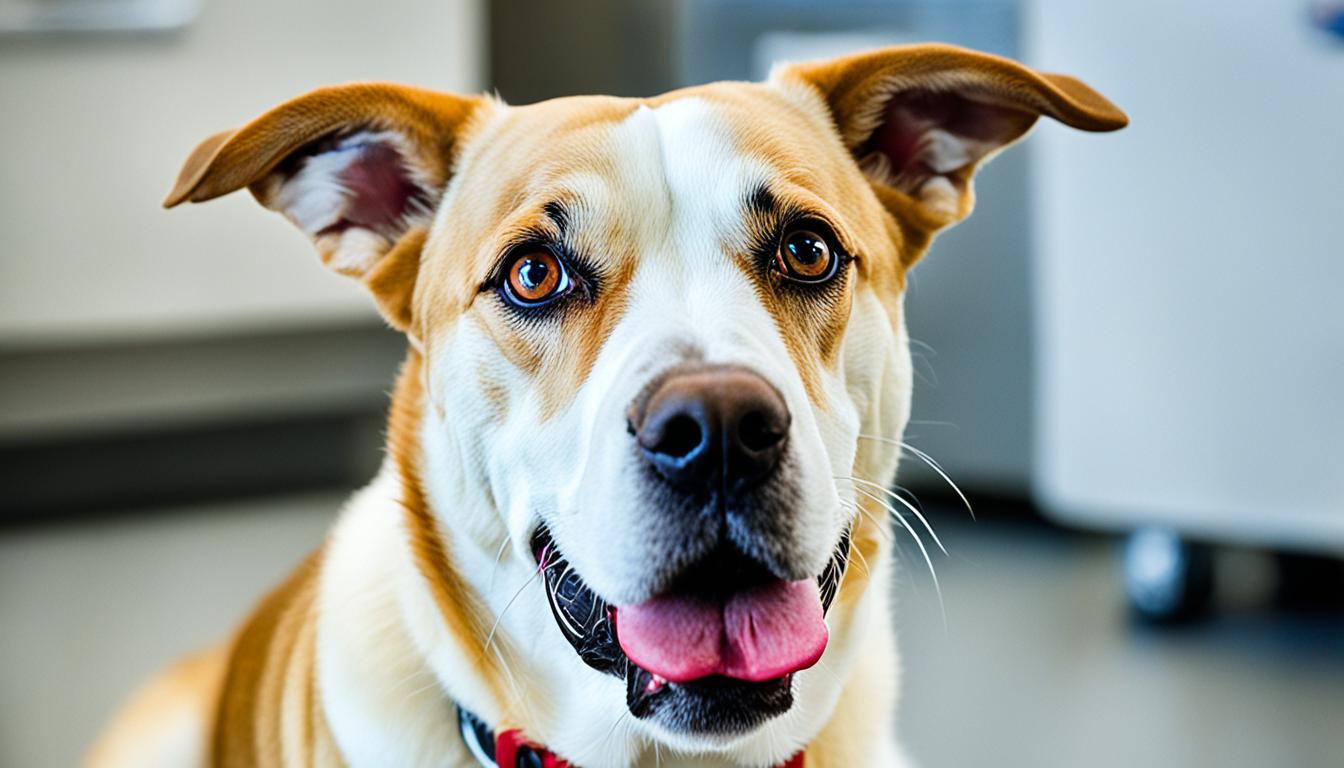Brachycephalic airway syndrome is a condition commonly seen in brachycephalic dog breeds, such as Bulldogs, Boxer Dogs, Pugs, and more. It is characterized by a set of upper airway abnormalities, including stenotic nares, extended nasopharyngeal turbinates, elongated soft palate, laryngeal collapse, everted laryngeal saccules, and hypoplastic trachea. These abnormalities can cause physical problems in affected dogs, leading to symptoms such as noisy breathing, snorting, snoring, coughing, gagging, exercise intolerance, and even collapse or fainting after exertion.
Brachycephalic airway syndrome can also lead to complications in the lungs and gastrointestinal tract. Diagnosis of this syndrome is made based on breed, clinical signs, and physical examination, which may require sedation or general anesthesia. Treatment options include weight loss for overweight dogs, conservative management, use of medications for short-term relief, and surgical correction for anatomical abnormalities. Surgery is the treatment of choice and has a higher success rate when performed early. The prognosis depends on the number of abnormalities present and the age of the dog at the time of diagnosis and treatment.
Key Takeaways:
- Brachycephalic airway syndrome is common in brachycephalic dog breeds.
- The syndrome is characterized by various upper airway abnormalities.
- Symptoms of the syndrome include noisy breathing, snorting, snoring, coughing, gagging, and exercise intolerance.
- Diagnosis is based on breed, clinical signs, and physical examination.
- Treatment options include weight loss, conservative management, medication, and surgery.
What is Brachycephalic Airway Syndrome?
Brachycephalic airway syndrome encompasses a range of upper airway abnormalities that commonly affect brachycephalic dogs. These abnormalities include stenotic nares, extended nasopharyngeal turbinates, elongated soft palate, laryngeal collapse, everted laryngeal saccules, and hypoplastic trachea. Each of these abnormalities contributes to increased airway resistance, resulting in various symptoms such as noisy breathing, snorting, snoring, coughing, gagging, exercise intolerance, and even collapse or fainting after exertion.
Dogs with multiple abnormalities tend to exhibit more severe signs of the syndrome. Furthermore, brachycephalic airway syndrome can have systemic effects, leading to changes in the lungs and gastrointestinal tract. These changes may include bronchial collapse, gastroesophageal reflux, and chronic gastritis.
In order to diagnose brachycephalic airway syndrome, veterinarians consider the dog’s breed, clinical signs, and conduct a thorough physical examination. Some components of the examination may necessitate the use of general anesthesia to perform a comprehensive evaluation of the upper airway.
Brachycephalic airway syndrome is a significant concern for brachycephalic breeds, as it can substantially impact their quality of life and overall health. Understanding the specific abnormalities involved in this syndrome is key to effective diagnosis and treatment.
Clinical Signs and Diagnosis
Dogs with brachycephalic airway syndrome can display a variety of clinical signs that vary depending on the severity of their abnormalities. These clinical signs are important for the identification and diagnosis of the syndrome.
Clinical Signs of Brachycephalic Airway Syndrome
The primary clinical signs of brachycephalic airway syndrome include noisy breathing, especially during exercise, snorting, snoring, coughing, gagging, retching, and vomiting. These dogs tend to find it easier to breathe through their mouths rather than their noses. They may also experience exercise intolerance and are more susceptible to overheating in hot or humid weather. The severity of these signs can be influenced by the presence of multiple abnormalities in affected dogs.
Clinical signs of brachycephalic airway syndrome include:
- Noisy breathing
- Snorting
- Snoring
- Coughing
- Gagging
- Retching
- Vomiting
- Difficulty breathing through the nose
- Exercise intolerance
- Increased susceptibility to overheating
Diagnosis of Brachycephalic Airway Syndrome
The diagnosis of brachycephalic airway syndrome is based on the dog’s breed, clinical signs, and physical examination. Certain breeds, such as Bulldogs, Boxer Dogs, and Pugs, are more predisposed to this condition. Visual examination of the nares can help diagnose stenotic nares, a common abnormality in these breeds. However, the elongated soft palate and everted laryngeal saccules require a more thorough examination under anesthesia.
A comprehensive physical examination under sedation or general anesthesia allows for a detailed evaluation of the upper airway and the diagnosis of these specific abnormalities. In some cases, chest x-rays may also be recommended to assess the lungs and lower airways for any secondary changes caused by the syndrome.
Clinical Signs of Brachycephalic Airway Syndrome
| Clinical Signs | Description |
|---|---|
| Noisy breathing | Audible sounds during breathing, especially during exercise |
| Snorting | Forceful inhalation through partially obstructed airways |
| Snoring | Loud and harsh breathing sounds during sleep or rest |
| Coughing | Episodic or persistent coughing |
| Gagging | Involuntary reflex caused by airway irritation or obstruction |
| Retching | Involuntary movement of the upper respiratory tract without vomiting |
| Vomiting | Forcefully expelling stomach contents |
| Difficulty breathing through the nose | Inability to breathe comfortably through the nostrils |
| Exercise intolerance | Inability to engage in prolonged or strenuous activities |
| Increased susceptibility to overheating | Greater risk of experiencing heat-related illnesses due to compromised respiratory function |
Treatment Options
The treatment approach for brachycephalic airway syndrome varies depending on the severity of the dog’s symptoms and the number of abnormalities present. It aims to alleviate respiratory distress and improve the overall quality of life for affected dogs.
- Weight loss: For overweight dogs, weight reduction is an essential part of the treatment plan. By achieving a healthy weight, the strain on the airways can be reduced, helping to alleviate symptoms.
- Conservative management: This approach involves implementing lifestyle modifications to minimize stress on the respiratory system. It includes controlling exercise levels, avoiding hot and humid conditions, providing a cool and comfortable environment, such as air-conditioned areas, and reducing sources of stress.
- Medication: Certain medications can provide short-term relief by reducing inflammation and managing symptoms. Among these are corticosteroids and nonsteroidal anti-inflammatory drugs (NSAIDs) to address inflammation. Oxygen therapy may also be used to support breathing in severe cases. However, it is important to note that medications do not correct the underlying anatomical abnormalities responsible for the syndrome.
Surgical Correction
Surgery is often the preferred treatment option when anatomical abnormalities significantly interfere with a dog’s breathing. It aims to correct the underlying issues causing airway obstruction and improve respiratory function.
The surgical procedures commonly performed for brachycephalic airway syndrome include:
| Procedure | Description |
|---|---|
| Stenotic nares correction | Stenotic nares, or narrow nostrils, can be surgically corrected by widening the nostrils. This helps improve airflow through the nasal passages. |
| Soft palate shortening (staphylectomy) | During this procedure, the excess length of the soft palate is surgically removed. By shortening the soft palate, the airway is widened, allowing for improved airflow and reducing the risk of airway obstruction. |
| Removal of everted laryngeal saccules | Everted laryngeal saccules, which are swollen pouches of tissue in the larynx, can be surgically removed. This helps to optimize the space available for airflow. |
The success of surgical correction depends on the timing of intervention. Early surgery tends to yield better outcomes, preventing further damage and enabling a dog to breathe more comfortably.
It is important to note that surgical correction should be performed by a qualified veterinarian who has experience in dealing with brachycephalic airway syndrome. Post-operative care and monitoring are essential to ensure proper healing and address any potential complications that may arise.
“Surgery aims to correct the underlying issues causing airway obstruction and improve respiratory function.”
By addressing the anatomical abnormalities contributing to brachycephalic airway syndrome, surgical correction offers a long-term solution to improve a dog’s breathing and overall well-being.
Surgical Intervention and Outcome
Surgical treatment plays a crucial role in effectively managing brachycephalic airway syndrome in dogs. The two most common surgical procedures performed for this condition are soft palate resection and stenotic nares correction.
Soft Palate Resection: The elongated soft palate, which obstructs the airway and contributes to breathing difficulties, can be surgically corrected through a procedure known as soft palate resection or staphylectomy. This involves the removal of the excess tissue that hinders proper airflow. By addressing the elongated soft palate, dogs experience improved breathing and reduced respiratory distress.
Stenotic Nares Correction: Stenotic nares, or narrowed nostrils, are another common anatomical abnormality in brachycephalic dogs. Surgical correction involves widening the nostrils to improve airflow and alleviate breathing difficulties. This procedure allows for easier inhalation and exhalation, promoting better oxygen exchange and reducing respiratory distress.
The success of surgical intervention depends on the severity of the abnormalities present and the age of the dog. Generally, younger dogs have a better prognosis and experience significant improvement in breathing and activity levels after surgery. However, older dogs, particularly those with advanced laryngeal collapse, may have a less favorable prognosis.
Post-operative Monitoring
After surgery, close post-operative monitoring is essential to ensure proper healing and address any potential complications. It is important to observe the dog’s recovery, paying attention to post-operative coughing, gagging, and swelling. In more severe cases, temporary tracheostomy may be required to facilitate breathing until the swelling subsides.
| Surgical Procedures | Outcome |
|---|---|
| Soft Palate Resection | Improved breathing, reduced respiratory distress |
| Stenotic Nares Correction | Easier inhalation and exhalation, better oxygen exchange |
Note: Outcome may vary depending on the severity of abnormalities and the dog’s age.
Aftercare and Prognosis
After surgical intervention for brachycephalic airway syndrome, close monitoring is essential to ensure proper healing and to address any complications. Pets may experience post-operative coughing and gagging, which is normal. In more severe cases, temporary tracheostomy may be necessary to facilitate breathing until the swelling subsides. The prognosis for dogs with brachycephalic airway syndrome depends on several factors, including the number of abnormalities present and the age of the dog at the time of treatment. Dogs that undergo surgery at a younger age generally have a better prognosis and see significant improvement in breathing and activity levels. However, dogs with advanced laryngeal collapse may have a poorer prognosis.
Breeding Considerations and Prevention
Ethical considerations should be taken into account when breeding dogs with brachycephalic airway syndrome, as the condition is directly related to the conformation of brachycephalic breeds.
Prevention of brachycephalic airway syndrome in future generations of dogs involves responsible breeding practices, which aim to produce offspring with better respiratory health.
Dogs with pronounced breathing difficulty or those requiring surgery to correct airway obstruction should not be used for breeding. It is generally recommended to spay or neuter these dogs at the time of surgical correction.
Increasing awareness and education about the risks associated with brachycephalic breeds can also help in preventing the syndrome.
Companion Care for Brachycephalic Dogs
Brachycephalic dogs require special care to ensure their well-being. These breeds, such as Bulldogs, Boxer Dogs, and Pugs, have unique respiratory needs due to their short snouts and flat faces.
One important aspect of caring for brachycephalic dogs is choosing the right equipment. It is recommended to use a harness instead of a regular neck collar. A harness distributes the pressure evenly across the chest and shoulders, alleviating any potential strain on the neck area. This helps prevent any discomfort or breathing difficulties that may occur with a collar.
Regular exercise is vital for all dogs, including brachycephalic breeds. However, it’s important to moderate their activity, especially in hot or humid weather. Brachycephalic dogs are more prone to overheating and respiratory distress due to their compromised airways. Keeping exercise sessions shorter and providing breaks in shaded areas can help prevent these issues.
Creating a cool and comfortable environment for brachycephalic dogs is crucial. These breeds are more sensitive to heat and humidity, so it’s important to provide them with an air-conditioned area or fans for ventilation. Adequate airflow helps them breathe more comfortably and reduces the risk of overheating.
Regular veterinary check-ups are essential for brachycephalic dogs. These visits allow the veterinarian to monitor their overall health, including respiratory function, and detect any potential issues early on. Weight management is also crucial for these breeds, as excess weight can exacerbate their respiratory difficulties. Maintaining a healthy weight through balanced nutrition and portion control helps reduce the strain on their airways and improves their overall well-being.
Remember, it’s important to provide careful and attentive care for brachycephalic dogs to ensure their quality of life. By using a harness, moderating exercise in hot weather, creating a comfortable environment, and prioritizing regular veterinary care, you can help your brachycephalic companion thrive.
Conclusion
Elongated soft palate is a commonly observed condition in dogs with brachycephalic airway syndrome. This condition can cause a range of respiratory symptoms and can also lead to complications in the lungs and gastrointestinal tract. Diagnosis of elongated soft palate is based on breed, clinical signs, and physical examination. Treatment options include weight loss, conservative management, short-term medications, and surgical correction.
Surgical intervention is often the preferred treatment for elongated soft palate, especially when it significantly affects a dog’s breathing. Early intervention yields better outcomes, and the prognosis depends on the severity of the abnormalities and the age of the dog. Responsible breeding practices play a crucial role in preventing and managing brachycephalic airway syndrome.
By understanding the causes and care of elongated soft palate in dogs, pet owners and breeders can provide the necessary attention and treatment to ensure the well-being and comfort of their beloved brachycephalic dogs.
FAQ
What is brachycephalic airway syndrome?
Brachycephalic airway syndrome is a condition characterized by a set of upper airway abnormalities in brachycephalic dog breeds. These abnormalities include stenotic nares, extended nasopharyngeal turbinates, elongated soft palate, laryngeal collapse, everted laryngeal saccules, and hypoplastic trachea.
What are the clinical signs and how is the diagnosis made?
Clinical signs of brachycephalic airway syndrome include noisy breathing, snorting, snoring, coughing, gagging, exercise intolerance, and collapse or fainting after exertion. Diagnosis is based on the breed, clinical signs, and physical examination, which may require sedation or general anesthesia.
What are the treatment options for brachycephalic airway syndrome?
Treatment options include weight loss for overweight dogs, conservative management, medications for short-term relief, and surgical correction of anatomical abnormalities that interfere with breathing.
How is surgical intervention performed and what is the outcome?
Surgical correction for brachycephalic airway syndrome may involve procedures such as soft palate resection and stenotic nares correction. The success of surgery depends on the severity of the abnormalities and the age of the dog at the time of treatment.
What is the aftercare and prognosis following surgery?
Close monitoring is crucial after surgery to ensure proper healing and address any complications. The prognosis depends on factors such as the number of abnormalities and the age of the dog. Early intervention generally yields better outcomes.
Are there any breeding considerations and ways to prevent brachycephalic airway syndrome?
Breeding dogs with pronounced breathing difficulty or those requiring airway obstruction surgery should be avoided. Responsible breeding practices aim to produce offspring with better respiratory health. Increased awareness and education about the risks associated with brachycephalic breeds can also help prevent the syndrome.
What are some companion care tips for brachycephalic dogs?
Brachycephalic dogs require special care, including using a harness instead of a regular collar, moderating exercise levels, providing a cool and comfortable environment, and ensuring regular veterinary check-ups and weight management.
Are there any tips for preventing elongated soft palate in dogs?
Elongated soft palate is commonly associated with brachycephalic airway syndrome. Preventing elongated soft palate involves responsible breeding practices and avoiding breeding dogs with pronounced breathing difficulty or those requiring airway obstruction surgery.
What are some other important facts about elongated soft palate in dogs?
Elongated soft palate is a common component of brachycephalic airway syndrome and can cause respiratory symptoms and additional complications in the lungs and gastrointestinal tract. Treatment options include weight loss, conservative management, medications for short-term relief, and surgical correction.






